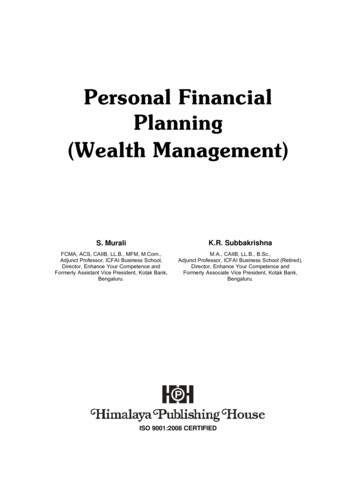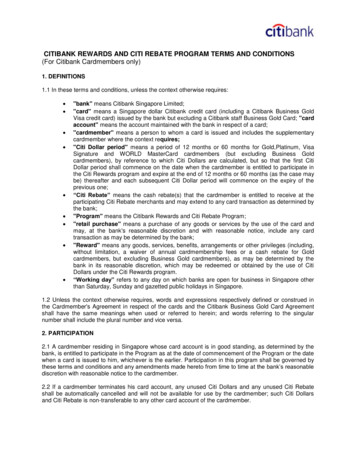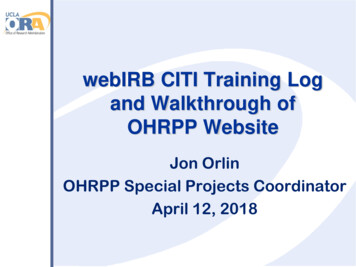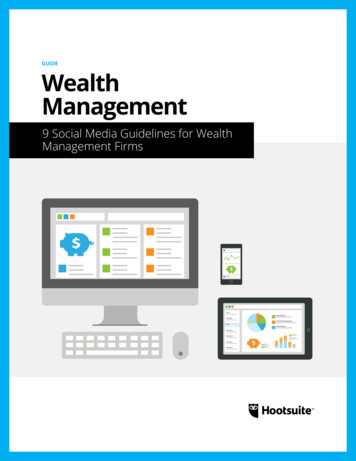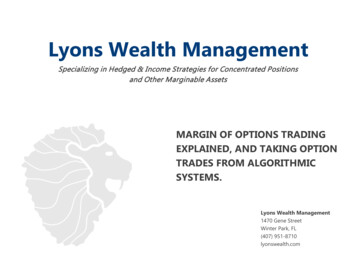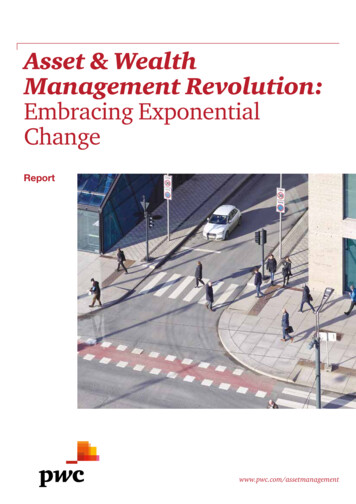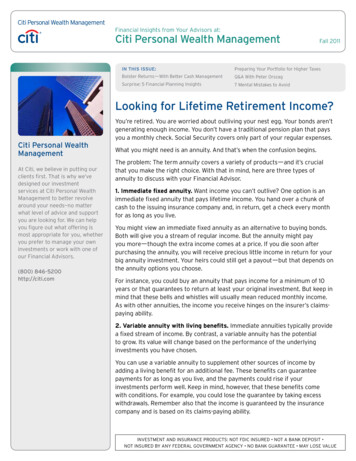
Transcription
Financial Insights from Your Advisors at:Citi Personal Wealth ManagementFall 2011in this issue:Preparing Your Portfolio for Higher TaxesBolster Returns—With Better Cash ManagementQ&A With Peter OrszagSurprise: 5 Financial Planning Insights7 Mental Mistakes to AvoidLooking for Lifetime Retirement Income?Citi Personal WealthManagementAt Citi, we believe in putting ourclients first. That is why we’vedesigned our investmentservices at Citi Personal WealthManagement to better revolvearound your needs—no matterwhat level of advice and supportyou are looking for. We can helpyou figure out what offering ismost appropriate for you, whetheryou prefer to manage your owninvestments or work with one ofour Financial Advisors.(800) 846-5200http://citi.comYou’re retired. You are worried about outliving your nest egg. Your bonds aren’tgenerating enough income. You don’t have a traditional pension plan that paysyou a monthly check. Social Security covers only part of your regular expenses.What you might need is an annuity. And that’s when the confusion begins.The problem: The term annuity covers a variety of products—and it’s crucialthat you make the right choice. With that in mind, here are three types ofannuity to discuss with your Financial Advisor.1. Immediate fixed annuity. Want income you can’t outlive? One option is animmediate fixed annuity that pays lifetime income. You hand over a chunk ofcash to the issuing insurance company and, in return, get a check every monthfor as long as you live.You might view an immediate fixed annuity as an alternative to buying bonds.Both will give you a stream of regular income. But the annuity might payyou more—though the extra income comes at a price. If you die soon afterpurchasing the annuity, you will receive precious little income in return for yourbig annuity investment. Your heirs could still get a payout—but that depends onthe annuity options you choose.For instance, you could buy an annuity that pays income for a minimum of 10years or that guarantees to return at least your original investment. But keep inmind that these bells and whistles will usually mean reduced monthly income.As with other annuities, the income you receive hinges on the insurer’s claimspaying ability.2. Variable annuity with living benefits. Immediate annuities typically providea fixed stream of income. By contrast, a variable annuity has the potentialto grow. Its value will change based on the performance of the underlyinginvestments you have chosen.You can use a variable annuity to supplement other sources of income byadding a living benefit for an additional fee. These benefits can guaranteepayments for as long as you live, and the payments could rise if yourinvestments perform well. Keep in mind, however, that these benefits comewith conditions. For example, you could lose the guarantee by taking excesswithdrawals. Remember also that the income is guaranteed by the insurancecompany and is based on its claims-paying ability.INVESTMENT AND INSURANCE PRODUCTS: NOT FDIC INSURED NOT A BANK DEPOSIT NOT INSURED BY ANY FEDERAL GOVERNMENT AGENCY NO BANK GUARANTEE MAY LOSE VALUE
3. Tax-deferred fixed annuity. These annuities payinterest until the end of the annuity’s term, at whichpoint your original investment plus the accumulatedincome is returned to you. All the income taxes due aredeferred until then.A tax-deferred fixed annuity might make sense for aconservative investor who wants to set aside somemoney for later in retirement and would benefit fromthe tax deferral. Keep in mind that you typically can’tget your money back before the end of the annuity’sterm without incurring a penalty.It’s important to understand that a variable annuity is a longterm, tax-deferred investment that is designed for retirement.Its value and rate of return will fluctuate with the performanceof the investment options you choose within the annuity. Anannuity allows you to create an income stream that can be fixedor variable. The performance of investment options within theannuity are subject to investment risk, including the potentialloss of the money you’ve invested. A variable annuity hascontract fees and charges.Taxable distributions (and certain deemed distributions) aresubject to ordinary income tax and, if taken prior to age 59½,may be subject to a 10% federal income tax penalty.Benefits are subject to state availability. See the prospectus forcomplete informationAll annuity and life insurance guarantees are based on theclaims-paying ability of the issuing insurance company.Bonds are affected by a number of risks, including fluctuationsin interest rates, credit risk and prepayment risk. In general, asprevailing interest rates rise, fixed income securities prices willfall. Bonds face credit risk if a decline in an issuer’s credit rating,or creditworthiness, causes a bond’s price to decline. High-yieldbonds are subject to additional risks such as increased risk ofdefault and greater volatility because of the lower credit qualityof the issues. Finally, bonds can be subject to prepayment risk.When interest rates fall, an issuer may choose to borrow moneyat a lower interest rate, while paying off its previously issuedbonds. As a consequence, underlying bonds will lose the interestpayments from the investment and will be forced to reinvest in amarket where prevailing interest rates are lower than when theinitial investment was made.Bolster Returns—With Better Cash ManagementStocks are struggling. Bond and savings yieldsare modest. How can you boost your returns? Youmight add another weapon to your arsenal: carefulcash management.2. Bank accounts. Do you keep a lot of moneyin a low-yield bank account in case of a financialemergency? Consider allocating some of this moneyto bonds, which likely pay somewhat more interest.The idea is to become more sophisticated in how youcover your living costs so you earn extra interest,collect credit card rewards, save on borrowing costsand avoid unnecessary tax bills. To that end, here are afew pointers:To be sure, if you need cash for an emergency, you mayfind you no longer have enough in your bank accountor money market fund. But you could always sell someof your bonds—though there’s a risk they may beworth less than the price you paid for them.1. Credit cards. Your credit cards may offer rewardsprograms that can help you earn frequent-flier miles,tickets to concerts and even cash rebates. If you useone or two cards for all your everyday spending, youcan build up rewards points fairly quickly.3. Taxable accounts. Let’s say you are reluctant tosell your bonds, preferring to wait and see whetherthey rebound in price. You also don’t want to unloadother investments because selling would trigger a bigcapital gains tax bill.Using credit cards also allows you to postpone payingfor purchases for perhaps a month or more withoutincurring interest costs, though you should pay closeattention to each card’s terms. In the meantime, themoney you have earmarked to pay for these purchasescould be sitting in an interest-earning account. Thisstrategy works best if you pay off your card balancesin full every month. If you don’t pay the balance in full,the charges you incur will likely be greater than thefinancial advantages you enjoy by using the cards.Another possibility: You might borrow against thevalue of your portfolio or home. More aggressiveinvestors sometimes hold investments in a marginaccount so they can borrow against their value topurchase more investments. But when you borrowagainst your portfolio, you don’t necessarily have tobuy more investments.Citi Personal Wealth ManagementInstead, you could use the money to, say, buy a newcar or pay an unexpected tax bill. These “nonpurpose”loans can be attractive because the interest ratecharged is often relatively low and approving the loanmay take only a few days.page 2
Be warned: Nonpurpose loans come with risk. If yourportfolio drops in value, your losses could quickly growand you might receive a margin call. At that point,you would need to add more securities or cash to theaccount or sell some investments to pay back part ofthe loan.You also might explore borrowing against your home’svalue through a home equity loan or line of credit.Let’s say you want to borrow 25,000 to upgrade yourkitchen. You might arrange a home equity loan. Theinterest rate charged should be lower than the rateon a credit card or an unsecured personal loan. Keepin mind that repaying such loans will increase yourmonthly expenses, so carefully consider whether youcan handle the debt payments involved.4. Retirement accounts. If you are under age 59 1/ 2,you usually can’t tap retirement accounts, such asyour IRA or 401(k), without incurring early withdrawalpenalties. True, you might be able to borrow as muchas 50,000 from your 401(k). But if you leave youremployer, you must repay these loans immediately oryou could incur taxes and penalties.Similarly, you may be able to withdraw your Roth IRAcontributions (but not the subsequent investmentgains) without tax consequences. But withdrawingyour contributions means losing the potential tax-freegrowth on this money.What to do? You may want to funnel some of yourmonthly savings into a regular taxable account. Thatway, if you suddenly need cash, you’ll have money youcan access without worrying about tax penalties.Although a money market fund seeks to preserve the valueof your investment at 1.00 per share, it is possible to losemoney by investing in the fund. An investment in the fund isnot insured or guaranteed by the Federal Deposit InsuranceCorporation or any other government agency.Remember, when investing in mutual funds and variableannuities, please consider the investment objectives, risks,charges and expenses associated with the funds and separateaccounts of the annuity carefully before investing. You mayobtain the appropriate prospectus by contacting a FinancialAdvisor. The prospectus contains this and other information,which should be carefully read before investing.A Home Equity Line of Credit is a form of revolving creditin which your home serves as collateral. Home equity planstypically involve variable interest rates rather than fixed rates.Costs to obtain a home equity line.Many of the costs in setting up a home equity line are similarto those you pay when buying a home. For example: a fee fora property appraisal, which estimates the value of your home;an application fee, which may not be refundable if you areturned down for credit; up-front charges, such as one or morepoints (one point equals 1% of the credit limit); other closingcosts, which include fees for attorneys, title search, mortgagepreparation and filing, property and title insurance as well astaxes; certain fees during the plan; for example, some plansimpose yearly membership or maintenance fees; you also may becharged a transaction fee every time you draw on the credit line.Borrowing against securities may not be suitable for everyone. Ifthe value of the securities should decline below a minimum level,you may be subject to a collateral call without specific advancenotice, requiring you to deposit additional cash or securities.If you cannot do so, all or a portion of your collateral could beliquidated, and a potentially taxable event could result. You arenot entitled to choose which securities are sold or any extensionof time to meet a collateral call. A concentrated portfolioholding a single or a few securities may be subject to greaterrisk of a collateral call than a diversified portfolio; a diversifiedportfolio will tend to be less subject to a sharp decline resultingfrom the negative performance of a single security. Availability,qualifications and other restrictions may vary by state. Ask youradvisor for details.Surprise: 5 Financial Planning InsightsDo you really need a financial plan? It might seem likea laborious exercise, with lots of questions to answerand financial information that needs to be gathered.But as a reward for your efforts, you could uncoversome startling insights into your financial situation.Here are five possible surprises.Citi Personal Wealth Management1. You own lots of investments, but you’re poorlydiversified. Over the years, you might have collecteda dizzying array of investments. Your financial planmay reveal that, quite apart from making your portfoliounwieldy, these investments, taken together, don’t forman intelligent portfolio.page 3
To get back on track, consider overhauling yourinvestment mix to create one that includes a wellrounded array of asset classes, including large andsmall U.S. stocks, developed foreign markets, emergingmarkets, high-quality bonds, and possibly alternativeinvestments. By combining a diverse collection ofinvestments, you won’t avoid short-term losses, butyou could reduce your portfolio’s overall volatility.But keep in mind that investments include risks andpossible loss of principal. Alternative investments(e.g., hedge funds, private equity) are speculative, notsuitable for all clients, and intended for experiencedand sophisticated investors who are willing to bearthe high economic risks of the investment. Small-capstocks carry greater risks than investments in larger,more established companies.If the overhaul is done in a tax-deferred account, suchas an Individual Retirement Account, you can makethe necessary trades without worrying about taxconsequences, as long as you don’t make a withdrawal.If you’re dealing with a taxable account, you might talkto your Financial Advisor about ways to help minimizetaxes as you remake your portfolio.2. Your kids’ college fund is wrecking yourretirement. You are determined to have enoughfor your children’s college costs, so you’re sockingaway every dollar you can into a 529 college savingsplan. Meanwhile, however, your financial plan mayindicate you aren’t setting aside nearly enough foryour own retirement.But failing to save enough won’t just imperil yourretirement. It could also mean missing out on valuabletax benefits and possibly a matching employercontribution in your 401(k) plan. An added bonus:Money in retirement accounts typically doesn’t denteligibility for financial aid.Indeed, thanks to financial aid, you may discover youdon’t have to pay the full cost of college. Even if yourchildren don’t qualify for grants and scholarships, theycould always take out student loans. By contrast, to payfor retirement, you typically need cold, hard cash.3. You might be saving too much. While manyAmericans are struggling to amass enough forretirement, your financial plan might suggest youhave the opposite problem: You’re saving too much.This may not seem like a problem. But if you’re puttingaside too much money for retirement and other longerterm goals, you could be missing out on experiencesCiti Personal Wealth Managementthat might enrich your life today, such as travel,charitable contributions and evenings out with friends.4. Your insurance coverage has holes. Maybe, whenyou last looked at your life insurance, you had enoughcoverage to take care of your spouse and pay off themortgage if you died.Since then, however, you’ve had kids, bought alarger house and perhaps started your own business.By drawing up a financial plan, you will have a bettersense for whether your life insurance coveragematches your situation.Your plan may also reveal that you need disabilityinsurance in case you can’t work for an extendedperiod and a long-term care policy for nursing-homeexpenses. The latter may not be needed for manyyears, but the annual premiums should be lower if youfirst buy the policy when you are younger.5. You’re headed for an estate tax problem. This yearand next, the federal estate tax exemption is 5 millionfor individuals and 10 million for couples. Don’t havenearly that much wealth? Estate taxes could still be anissue for three reasons.First, your financial plan may indicate that yourwealth could grow substantially between now and thetime of your death, so estate taxes could indeed bea problem. Second, unless Congress acts, the federalestate tax exemption will revert to 1 million in 2013.Finally, even if your estate isn’t taxable at the federallevel, it could be subject to estate taxes at the statelevel, so you should probably seek advice from aqualified tax professional.Diversification does not guarantee a profit or protect againsta loss.A change to your current policy may incur charges, fees andcosts. A new policy will require a medical exam.Since life insurance and long-term care insurance are medicallyunderwritten, you should not cancel your current policy untilyour new policy is in force. Your actual premiums may varyfrom any initial quotation you receive. A change to your currentpolicy may incur charges, fees and costs. A new policy willrequire a medical exam. Surrender charges may be imposed, andthe period of time for which the surrender charges apply mayincrease with a new policy. You should consult with your own taxadvisors regarding your potential tax liability on surrenders.Before entering into a plan, consider how you will pay back anymoney you might borrow. Some plans set minimum paymentsthat cover a portion of the principal (the amount you borrow)plus accrued interest. But, unlike the typical installment loan, theportion that goes toward principal may not be enough to repaythe debt by the end of the term.page 4
Citigroup Inc. and its affiliates do not provide tax or legal advice.To the extent that this material or any attachment concernstax matters, it is not intended to be used and cannot be used bya taxpayer for the purpose of avoiding penalties that may beimposed by law. Any such taxpayer should seek advice basedon the taxpayer’s particular circumstances from an independenttax advisor.Preparing Your Portfolio for Higher TaxesThe bad news: Higher federal income taxes may lieahead. The good news: You have more than a yearto get ready—and you might want to start makingadjustments in 2011.Your children will need to take annual distributions. Butas designated beneficiaries, your children could teasedecades of tax-free growth out of their inherited Rothif they’re careful.Yes, Congress extended the Bush-era tax cuts at theend of 2010. But it didn’t extend those cuts past 2012,which means higher federal tax rates in 2013 can’t beruled out.2. Make the most of tax-favored investments. If taxrates do go up, municipal bonds may become moreattractive. For example, a 3% municipal bond has a taxequivalent yield of some 4.6% at today’s top federalrate of 35%. But if the top rate rises to, say, 40%, thetax-equivalent yield would climb to 5%.Even if the Bush-era tax cuts are extended again,upper-income Americans are already looking athigher taxes in 2013, thanks to a special Medicare taxincrease included in the 2010 health care law. The 3.8%Medicare tax, which can also hit investment gains, willaffect couples with modified adjusted gross income ofmore than 250,000 and individuals above 200,000.To prepare yourself for the possibility of higher taxes,consider a twofold strategy.1. Shift income into 2011 and 2012. Without a newlaw, the long-term capital gains rate will rise from 15%in 2011 and 2012 to 20% in 2013. Even if the 15% rateis extended, high-income families may be hit by theMedicare tax. One implication: If you have appreciatedstock in your taxable account that you’re contemplatingselling, you may want to sell in 2011 or 2012, or possiblysplit the income between the two years.Similarly, if you have a traditional Individual RetirementAccount, you might consider converting it to a RothIRA so you can pay the conversion tax at today’s lowerincome tax rates. Converting may make sense if youexpect to be taxed at the same or a higher rate inretirement—and you have funds outside your IRA topay the tax bill on the taxable sum converted. If youpay any taxes triggered by the Roth conversion withmoney from your IRA, you may end up incurring bothincome taxes and a tax penalty.A Roth conversion could also be appealing if you planto bequeath your IRA. If you have a Roth, you don’thave to take required minimum distributions, as youdo with a traditional IRA, so you could leave theaccount intact for your children or other beneficiaries.Citi Personal Wealth ManagementWhile you’re at it, look into increasing your retirementaccount contributions so you can shelter ongoing gainsfrom both the Medicare tax and any future generaltax increases. In 2011, you can contribute as much as 16,500 to a 401(k) plan, or 22,000 if you are age50 or older. Meanwhile, this year’s maximum IRAcontribution is 5,000, or 6,000 for those age 50 andabove. Going forward, all these contribution limits willincrease based on an inflation index.Also, think carefully about which investments you buywithin your retirement accounts. It typically makessense to use IRAs and 401(k) plans for tax-inefficientstrategies, such as buying taxable bonds and realestate investment trusts, which tend to generate a lotof immediately taxable income.To that list, you might want to add dividend-payingstocks. High-income earners may have to pay theMedicare tax on dividends starting in 2013. Also,Congress might not extend the special tax treatmentfor qualifying dividends beyond 2012. Currently,dividends are taxed at a 15% maximum federal rate.But without a new tax law, they could once again betaxed as ordinary income, which could push the toprate to over 40%.Looking for more year-end tax tips? Ask your FinancialAdvisor for our 2011 tax-planning checklist.page 5
Q&A With Peter OrszagThe federal government’s budget deficit has emergedas perhaps this year’s most hotly debated politicalissue, thanks in part to the wrangling over the debtceiling and Standard & Poor’s decision to lower itscredit rating for U.S. Treasury bonds.For a fresh perspective on the issue, we turned to PeterOrszag, Citi’s vice chairman of global banking. Peterpreviously served as President Obama’s director of theOffice of Management and Budget. He has also workedas director of the Congressional Budget Office.Q: In your writings, you’ve mentioned that growthtends to be sluggish in economic recoveries that followa severe financial crisis. Can the U.S. avoid that fate—or is it pretty much a sure thing, given the depressedstate of the U.S. housing market and the amount ofconsumer debt?Peter Orszag: History suggests it’ll be a hard slog. Thatmeans we need to adjust expectations. It also meanswe should put more emphasis on fixing the housingsector. From a macro perspective, I’m most concernedabout clearing the excess inventory of housing,because that’s depressing home prices. For instance,you might create a government program to transformsome properties into rentals, so the properties aren’tweighing on the market, or you might acceleratedepreciation on residential housing held by investors.With regard to fiscal policy, we need to emphasize bothfiscal stimulus in the short term and deficit reductionin the long term. Creating a path to a sustainable longterm fiscal situation will help confidence. The lack of acredible long-term fiscal path would make short-termstimulus less effective than it could be.Q: We hear a lot about the need to raise the eligibilityage for Social Security, cut back benefits or both. Butisn’t Medicare the real problem?PO: Medicare and Medicaid spending is currently equalto around 51/ 2% of GDP, while Social Security is a littleunder 5%. By 2050, Social Security goes from 5% to6% of GDP, while Medicare and Medicaid go from 51/ 2%to 12%. It’s important to deal with Social Security. Butthe major problem is health care, particularly the highcosts incurred by a relatively small number of patients.A quarter of Medicare participants account for 85% ofthe program’s expenses.Citi Personal Wealth ManagementQ: Do you think it’s inevitable that Americans will paymore in taxes in the years ahead?PO: Over the next 10 to 15 years, it’s difficult to see howwe get to a sustainable fiscal situation without morerevenue, in part because any changes to entitlementprograms are likely to be phased in slowly. But to reacha sustainable fiscal situation between now and 2050,we will need to address spending, especially spendingon health care.Q: What do you think the aging population will meanfor economic growth and the typical retirement age?PO: An aging population means slower growth becausethe work force will grow more slowly, unless we have achange in immigration policy. Meanwhile, for the bulk ofthe population, there’s no question in my mind that weshould be encouraging people to work longer. It’s goodfor the country, but it’s also good for individuals. When Ilook around, the people who remain most active are theones who seem to be enjoying their later years the most.Q: If you were advising folks who were preparing forretirement, what steps would you suggest they take?PO: You clearly want to save enough. But there arealso three other issues that people approachingretirement should think about: how they might tapinto the equity in their home, how they can protectthemselves against outliving their assets and how theymight pay for long-term care costs. There are alreadyproducts available that can help you address theseissues, such as reverse mortgages, lifetime-incomeannuities and long-term care insurance, althougheach of them has shortcomings. As demand for theseproducts picks up, I hope the choices will improve inthe years ahead.Forecasts may not be attained. The views of theinterviewee may differ from the views of Citi PersonalWealth Management.Reverse Mortgages are complex; be sure to understand all theterms and conditions (including the Total Annual Loan Cost) andconsequences of reverse mortgages.page 6
7 Mental Mistakes to AvoidWhen markets drop, we might lose money. Perhapsa bigger problem: We often also lose sleep, loseperspective—and end up straying from the strategywe settled on in calmer times.Has this year’s market turmoil jangled your nerves?It is, alas, all too easy to get emotionally caught upin the markets’ day-to-day price swings. Still, byunderstanding some of the mental mistakes identifiedby behavioral finance experts, you might find you’rebetter able to cope with market turmoil. Here are sevencommon mistakes.1. Suffering losses. Research suggests we get farmore pain from losses than pleasure from gains, whichis why bear markets can be so painful. Our aversionto realizing losses can stop us from selling rotteninvestments that we ought to get rid of.4. Feeling cocky. We tend to think we’re smarter thanwe really are and that we know more than we really do.Our overconfidence can climb along with the markets,as we attribute our portfolio’s gains to our ownbrilliance. This may lead some folks to trade excessivelyand to take on too much risk.5. Predicting the past. In retrospect, it might seemobvious that stocks would weaken this year after thebig gains since early 2009. Indeed, it’s easy to forgetabout all the bullishness among investors earlier in 2011and convince ourselves that we foresaw the summermarket slump. This so-called hindsight bias can furtherbolster our confidence, possibly prompting us to makebold market forecasts and then act upon them, eventhough past performance is often a rotten guide tofuture results.Sometimes, however, our fear of losses can be ahelpful trait. Many investors hate to sell when theirinvestments are underwater, instead hanging on tolosing positions, hoping to get even, then get out.6. Seeking confirmation. We tend to latch on toevidence that supports our beliefs, while discountingcontradictory evidence. For instance, bullish investorswill ignore bad economic news, while bearish investorswill dismiss positive developments.This loss aversion can keep us invested in stocksduring a bear market, so we potentially benefit fromany market recovery. We might become anchored onthe price we paid for our investments or the highestprice they got to, and we’re reluctant to sell until ourinvestments return to those levels.7. Raising risk. During bull markets, our appetitefor risk can balloon because of the “house money”effect. Like casino gamblers who get lucky early in theevening, we may feel like we’re ahead of the game andwe can afford to take more risk.2. Sitting tight. Our reluctance to sell is also fueled bystatus quo bias, our preference for staying put ratherthan changing.But failing to change can sometimes be risky. Imagineyou have a big position in a single stock. It might beshares that you inherited or that you received fromyour employer through stock options. While sittingtight may feel like the right thing to do, it could be wiseto sell your big stock position and spread the proceedsamong a broader collection of stocks and possiblyother investments.3. Extending trends. We often read too much intorecent market action. For example, when stock pricesrise, we may extrapolate the trend and assume shareswill continue climbing. This can prompt us to load up onstocks even though prices are significantly higher thanthey were just a few months earlier.Citi Personal Wealth ManagementTrouble is, the house-money effect—coupled with ouroverconfidence and tendency to extrapolate markettrends—may lead us to take excessive risk late in a bullmarket, potentially setting us up for nasty losses if themarket turns lower.Investment results may vary. The investment strategiespresented are not appropriate for every investor. You shouldreview each individual client’s situation, including the terms,conditions, fees, charges, expenses and risks involved withspecific products or services.Investments are subject to market risk, fluctuation in value andpossible loss of principal. Before investing, investors shouldconsider whether tax or other benefits are only available forinvestments in the investor’s and designated beneficiary’shome-state 529 College Savings Plan.Sources: To read more about behavioral finance, see BehavioralFinance and W
Citi Personal Wealth Management page 2. Citi Personal Wealth Management page 3 Be warned: Nonpurpose loans come with risk. If your portfolio drops in value, your losses could quickly grow and you might receive a margin call. At that po
